

CCT-K3, CCT-K3.1 and CCT-K3.2
Realizations of the ITS-90 from 83.8058 K to 933.473 K
NOMINAL TEMPERATURE : Argon Triple Point, 83.8058 K
Measurand : Resistance ratio, W, at fixed-point temperature
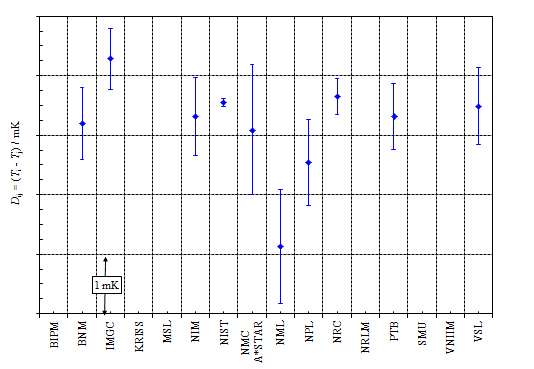
CCT-K3, CCT-K3.1 and CCT-K3.2
Realizations of the ITS-90 from 83.8058 K to 933.473 K
NOMINAL TEMPERATURE : Mercury Triple Point, 234.3156 K
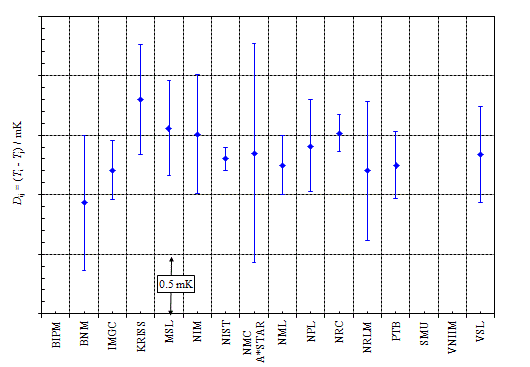
CCT-K3, CCT-K3.1 and CCT-K3.2
Realizations of the ITS-90 from 83.8058 K to 933.473 K
NOMINAL TEMPERATURE : Gallium Melting Point, 302.9146 K
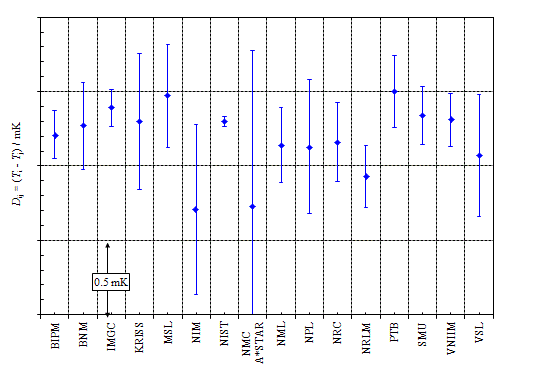
Realizations of the ITS-90 from 83.8058 K to 933.473 K
NOMINAL TEMPERATURE : Indium Freezing Point, 429.7485 K
Click on one of the following links to access to the graphs of equivalence relative to each of the participating laboratories in CCT-K3:
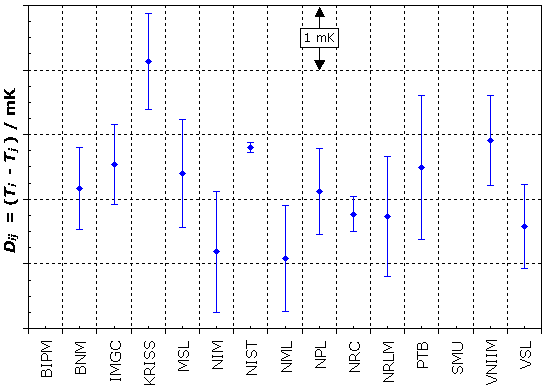
Realizations of the ITS-90 from 83.8058 K to 933.473 K
NOMINAL TEMPERATURE : Tin Freezing Point, 505.078 K
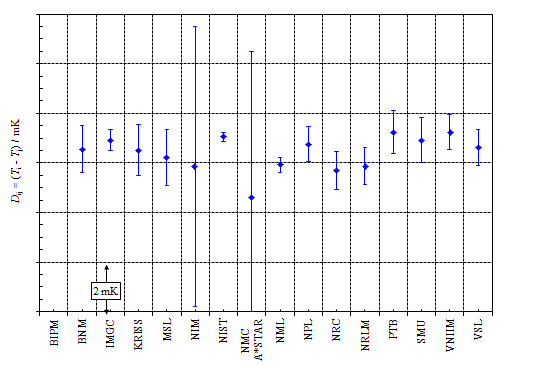
CCT-K3, CCT-K3.1 and CCT-K3.2
Realizations of the ITS-90 from 83.8058 K to 933.473 K
NOMINAL TEMPERATURE : Zinc Freezing Point, 692.677 K
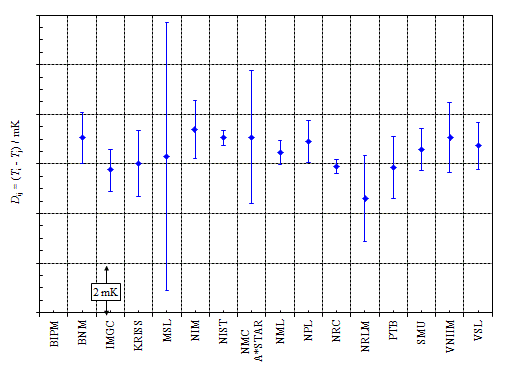
Realizations of the ITS-90 from 83.8058 K to 933.473 K
NOMINAL TEMPERATURE : Aluminum Freezing Point, 933.473 K
Click on one of the following links to access to the graphs of equivalence relative to each of the participating laboratories in CCT-K3:
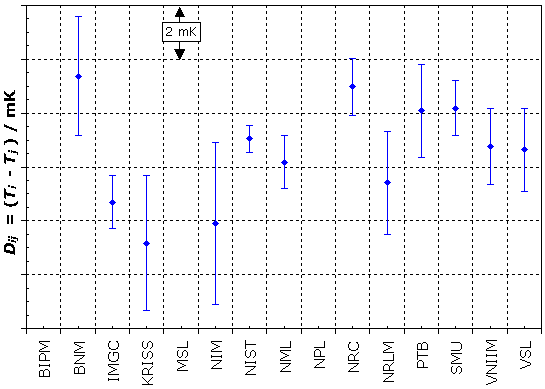
CCT-K3, CCT-K3.1 and CCT-K3.2
Realizations of the ITS-90 from 83.8058 K to 933.473 K
NOMINAL TEMPERATURE : Argon Triple Point, 83.8058 K
Measurand : Resistance ratio, W, at fixed-point temperature
Click on Matrix of equivalence to view the degrees of equivalence
Dij and expanded uncertainty Uij
(at a 95% level of confidence), expressed in mK
Unless otherwise stated, in the final numbers presented in the Matrices of equivalence, rounding has been applied according to ISO-31-0 Annex B Rule B.
CCT-K3, CCT-K3.1 and CCT-K3.2
Realizations of the ITS-90 from 83.8058 K to 933.473 K
NOMINAL TEMPERATURE : Mercury Triple Point, 234.3156 K
Click on Matrix of equivalence to view the degrees of equivalence
Dij and expanded uncertainty Uij
(at a 95% level of confidence), expressed in mK
Unless otherwise stated, in the final numbers presented in the Matrices of equivalence, rounding has been applied according to ISO-31-0 Annex B Rule B.
CCT-K3, CCT-K3.1 and CCT-K3.2
Realizations of the ITS-90 from 83.8058 K to 933.473 K
NOMINAL TEMPERATURE : Gallium Melting Point, 302.9146 K
Click on Matrix of equivalence to view the degrees of equivalence
Dij and expanded uncertainty Uij
(at a 95% level of confidence), expressed in mK
Unless otherwise stated, in the final numbers presented in the Matrices of equivalence, rounding has been applied according to ISO-31-0 Annex B Rule B.
Realizations of the ITS-90 from 83.8058 K to 933.473 K
NOMINAL TEMPERATURE : Indium Freezing Point, 429.7485 K
Click on Matrix of equivalence to view the degrees of equivalence
Dij and expanded uncertainty Uij
(at a 95% level of confidence), expressed in mK
Unless otherwise stated, in the final numbers presented in the Matrices of equivalence, rounding has been applied according to ISO-31-0 Annex B Rule B.
CCT-K3, CCT-K3.1 and CCT-K3.2
Realizations of the ITS-90 from 83.8058 K to 933.473 K
NOMINAL TEMPERATURE : Tin Freezing Point, 505.078 K
Click on Matrix of equivalence to view the degrees of equivalence
Dij and expanded uncertainty Uij
(at a 95% level of confidence), expressed in mK
Unless otherwise stated, in the final numbers presented in the Matrices of equivalence, rounding has been applied according to ISO-31-0 Annex B Rule B.
CCT-K3, CCT-K3.1 and CCT-K3.2
Realizations of the ITS-90 from 83.8058 K to 933.473 K
NOMINAL TEMPERATURE : Zinc Freezing Point, 692.677 K
Click on Matrix of equivalence to view the degrees of equivalence
Dij and expanded uncertainty Uij
(at a 95% level of confidence), expressed in mK
Unless otherwise stated, in the final numbers presented in the Matrices of equivalence, rounding has been applied according to ISO-31-0 Annex B Rule B.
Realizations of the ITS-90 from 83.8058 K to 933.473 K
NOMINAL TEMPERATURE : Aluminum Freezing Point, 933.473 K
Click on Matrix of equivalence to view the degrees of equivalence
Dij and expanded uncertainty Uij
(at a 95% level of confidence), expressed in mK
Unless otherwise stated, in the final numbers presented in the Matrices of equivalence, rounding has been applied according to ISO-31-0 Annex B Rule B.
| Metrology area, Sub-field | Thermometry, Standard Platinum Resistance Thermometers |
| Description | Realizations of the ITS-90 from 273.16 K to 302.9146 K |
| Time of measurements | 2009 |
| Status | Approved for equivalence |
| Final Reports of the comparisons | |
| References | |
| Measurand | Temperature: 273.16 K to 302.9146 K |
| Transfer device | Two standard platinum resistance thermometers |
| Comparison type | Key Comparison |
| Consultative Committee | CCT (Consultative Committee for Thermometry) |
| Conducted by | CCT (Consultative Committee for Thermometry) |
| Comments | Measurements were carried out at one temperature: Gallium (Ga) Melting Point, 302.9146 K Results were published in 2011 |
| Pilot institute |
BIPM
Bureau International des Poids et Mesures BIPM - International Organization |
| Contact person | Susanne Picard +33 (0) 1 45 07 70 27 |
This page proposes print-out on A4 paper (portrait) of the comparison details (best printed out using a black and white printer).
Please, select items to be printed out, then click on "OK" :
CCT-K3, CCT-K3.1 and CCT-K3.2
Realizations of the ITS-90 from 83.8058 K to 933.473 K
NOMINAL TEMPERATURE : Argon Triple Point, 83.8058 K
Measurand : Resistance ratio, W, at fixed-point temperature
|
| The degree of equivalence between two laboratories is given by a pair of terms: Dij = Di - Dj = Ti - Tj and the expanded uncertainty (95%) Uij of Dij, both expressed in mK. |
|
The pair-wise temperature differences and their associated uncertainties were calculated for the various laboratories by two paths. Those paths are indicated by the terms ‘direct’ and ‘inclusive’, or the corresponding abbreviations ‘dir.’ and ‘inc.’, and yield results that are indicated in the equivalence matrices and graphs by the same terms. In some cases, the paths are identical. The ‘direct’ differences are the temperature differences between the realizations of a pair of laboratories that were obtained using the shortest available path linking those laboratories. In some cases, this means that the laboratories are compared using measurements made on the same SPRT or SPRTs. Where necessary, however, NIST or NML serves as an intermediary, linking the measurements of the two laboratories. The ‘inclusive’ differences are those in which all of the data obtained by the pair of laboratories involved are used in the calculations of their pair-wise temperature differences and their associated uncertainties. In inclusive differences, whether or not there is a direct linkage between the laboratories, NIST (and possibly also NML) may be used as an intermediary so that the temperature differences can be computed using all relevant data. For the inclusive path, NIST was selected as the intermediate laboratory because, overall, that results in a minimum number of intermediate laboratories in the pair-wise differences. The expanded uncertainty, UL (95%), listed in the matrices of equivalence and used in the ‘no baseline’ graphs of approximate equivalence is derived for each laboratory by combining the Type A standard uncertainty for the smallest number of measurements (n) across SPRTs and the Type B standard uncertainty for each fixed point. The uncertainty UL (95%) is only for the respective laboratory with no contribution from the other laboratories. |
CCT-K3, CCT-K3.1 and CCT-K3.2
Realizations of the ITS-90 from 83.8058 K to 933.473 K
NOMINAL TEMPERATURE : Mercury Triple Point, 234.3156 K
Measurand : Resistance ratio, W, at fixed-point temperature
The pair-wise temperature differences and their associated uncertainties were calculated for the various laboratories by two paths. Those paths are indicated by the terms ‘direct’ and ‘inclusive’, or the corresponding abbreviations ‘dir.’ and ‘inc.’, and yield results that are indicated in the equivalence matrices and graphs by the same terms. In some cases, the paths are identical. The ‘direct’ differences are the temperature differences between the realizations of a pair of laboratories that were obtained using the shortest available path linking those laboratories. In some cases, this means that the laboratories are compared using measurements made on the same SPRT or SPRTs. Where necessary, however, NIST or NML serves as an intermediary, linking the measurements of the two laboratories. The ‘inclusive’ differences are those in which all of the data obtained by the pair of laboratories involved are used in the calculations of their pair-wise temperature differences and their associated uncertainties. In inclusive differences, whether or not there is a direct linkage between the laboratories, NIST (and possibly also NML) may be used as an intermediary so that the temperature differences can be computed using all relevant data. For the inclusive path, NIST was selected as the intermediate laboratory because, overall, that results in a minimum number of intermediate laboratories in the pair-wise differences. The expanded uncertainty, UL (95%), listed in the matrices of equivalence and used in the ‘no baseline’ graphs of approximate equivalence is derived for each laboratory by combining the Type A standard uncertainty for the smallest number of measurements (n) across SPRTs and the Type B standard uncertainty for each fixed point. The uncertainty UL (95%) is only for the respective laboratory with no contribution from the other laboratories.
Key comparison reference value:
The contents of the Appendix B of the MRA for CCT Key Comparison 3 were approved by a majority vote of the CCT. Due to the myriad of technical problems, it was not possible to reach a consensus on whether 1) to use a key comparison reference value, or 2) not to use a key comparison value. The viewpoints of the NMI participants are contained within the CCT-K3 Final Report (NIST Technical Note 1450).
The CCT agrees by consensus that the absence of a key comparison reference value in this Appendix does not preclude the use of a key comparison refrence value in other key comparisons.
The degree of equivalence between two laboratories is given by a pair of terms:
Dij = Di - Dj = Ti - Tj and the expanded uncertainty (95%) Uij of Dij, both expressed in mK.
CCT-K3, CCT-K3.1 and CCT-K3.2
Realizations of the ITS-90 from 83.8058 K to 933.473 K
NOMINAL TEMPERATURE : Gallium Melting Point, 302.9146 K
Measurand : Resistance ratio, W, at fixed-point temperature
|
| The degree of equivalence between two laboratories is given by a pair of terms: Dij = Di - Dj = Ti - Tj and the expanded uncertainty (95%) Uij of Dij, both expressed in mK. |
|
The pair-wise temperature differences and their associated uncertainties were calculated for the various laboratories by two paths. Those paths are indicated by the terms ‘direct’ and ‘inclusive’, or the corresponding abbreviations ‘dir.’ and ‘inc.’, and yield results that are indicated in the equivalence matrices and graphs by the same terms. In some cases, the paths are identical. The ‘direct’ differences are the temperature differences between the realizations of a pair of laboratories that were obtained using the shortest available path linking those laboratories. In some cases, this means that the laboratories are compared using measurements made on the same SPRT or SPRTs. Where necessary, however, NIST or NML serves as an intermediary, linking the measurements of the two laboratories. The ‘inclusive’ differences are those in which all of the data obtained by the pair of laboratories involved are used in the calculations of their pair-wise temperature differences and their associated uncertainties. In inclusive differences, whether or not there is a direct linkage between the laboratories, NIST (and possibly also NML) may be used as an intermediary so that the temperature differences can be computed using all relevant data. For the inclusive path, NIST was selected as the intermediate laboratory because, overall, that results in a minimum number of intermediate laboratories in the pair-wise differences. The expanded uncertainty, UL (95%), listed in the matrices of equivalence and used in the ‘no baseline’ graphs of approximate equivalence is derived for each laboratory by combining the Type A standard uncertainty for the smallest number of measurements (n) across SPRTs and the Type B standard uncertainty for each fixed point. The uncertainty UL (95%) is only for the respective laboratory with no contribution from the other laboratories. |
Realizations of the ITS-90 from 83.8058 K to 933.473 K
NOMINAL TEMPERATURE : Indium Freezing Point, 429.7485 K
Measurand : Resistance ratio, W, at fixed-point temperature
|
| The degree of equivalence between two laboratories is given by a pair of terms: Dij = Di - Dj = Ti - Tj and the expanded uncertainty (95%) Uij of Dij, both expressed in mK. |
|
The pair-wise temperature differences and their associated uncertainties were calculated for the various laboratories by two paths. Those paths are indicated by the terms ‘direct’ and ‘inclusive’, or the corresponding abbreviations ‘dir.’ and ‘inc.’, and yield results that are indicated in the equivalence matrices and graphs by the same terms. In some cases, the paths are identical. The ‘direct’ differences are the temperature differences between the realizations of a pair of laboratories that were obtained using the shortest available path linking those laboratories. In some cases, this means that the laboratories are compared using measurements made on the same SPRT or SPRTs. Where necessary, however, NIST or NML serves as an intermediary, linking the measurements of the two laboratories. The ‘inclusive’ differences are those in which all of the data obtained by the pair of laboratories involved are used in the calculations of their pair-wise temperature differences and their associated uncertainties. In inclusive differences, whether or not there is a direct linkage between the laboratories, NIST (and possibly also NML) may be used as an intermediary so that the temperature differences can be computed using all relevant data. For the inclusive path, NIST was selected as the intermediate laboratory because, overall, that results in a minimum number of intermediate laboratories in the pair-wise differences. The expanded uncertainty, UL (95%), listed in the matrices of equivalence and used in the ‘no baseline’ graphs of approximate equivalence is derived for each laboratory by combining the Type A standard uncertainty for the smallest number of measurements (n) across SPRTs and the Type B standard uncertainty for each fixed point. The uncertainty UL (95%) is only for the respective laboratory with no contribution from the other laboratories. |
CCT-K3, CCT-K3.1 and CCT-K3.2
Realizations of the ITS-90 from 83.8058 K to 933.473 K
NOMINAL TEMPERATURE : Tin Freezing Point, 505.078 K
Measurand : Resistance ratio, W, at fixed-point temperature
|
| The degree of equivalence between two laboratories is given by a pair of terms: Dij = Di - Dj = Ti - Tj and the expanded uncertainty (95%) Uij of Dij, both expressed in mK. |
|
The pair-wise temperature differences and their associated uncertainties were calculated for the various laboratories by two paths. Those paths are indicated by the terms ‘direct’ and ‘inclusive’, or the corresponding abbreviations ‘dir.’ and ‘inc.’, and yield results that are indicated in the equivalence matrices and graphs by the same terms. In some cases, the paths are identical. The ‘direct’ differences are the temperature differences between the realizations of a pair of laboratories that were obtained using the shortest available path linking those laboratories. In some cases, this means that the laboratories are compared using measurements made on the same SPRT or SPRTs. Where necessary, however, NIST or NML serves as an intermediary, linking the measurements of the two laboratories. The ‘inclusive’ differences are those in which all of the data obtained by the pair of laboratories involved are used in the calculations of their pair-wise temperature differences and their associated uncertainties. In inclusive differences, whether or not there is a direct linkage between the laboratories, NIST (and possibly also NML) may be used as an intermediary so that the temperature differences can be computed using all relevant data. For the inclusive path, NIST was selected as the intermediate laboratory because, overall, that results in a minimum number of intermediate laboratories in the pair-wise differences. The expanded uncertainty, UL (95%), listed in the matrices of equivalence and used in the ‘no baseline’ graphs of approximate equivalence is derived for each laboratory by combining the Type A standard uncertainty for the smallest number of measurements (n) across SPRTs and the Type B standard uncertainty for each fixed point. The uncertainty UL (95%) is only for the respective laboratory with no contribution from the other laboratories. |
CCT-K3, CCT-K3.1 and CCT-K3.2
Realizations of the ITS-90 from 83.8058 K to 933.473 K
NOMINAL TEMPERATURE : Zinc Freezing Point, 692.677 K
Measurand : Resistance ratio, W, at fixed-point temperature
|
| The degree of equivalence between two laboratories is given by a pair of terms: Dij = Di - Dj = Ti - Tj and the expanded uncertainty (95%) Uij of Dij, both expressed in mK. |
|
The pair-wise temperature differences and their associated uncertainties were calculated for the various laboratories by two paths. Those paths are indicated by the terms ‘direct’ and ‘inclusive’, or the corresponding abbreviations ‘dir.’ and ‘inc.’, and yield results that are indicated in the equivalence matrices and graphs by the same terms. In some cases, the paths are identical. The ‘direct’ differences are the temperature differences between the realizations of a pair of laboratories that were obtained using the shortest available path linking those laboratories. In some cases, this means that the laboratories are compared using measurements made on the same SPRT or SPRTs. Where necessary, however, NIST or NML serves as an intermediary, linking the measurements of the two laboratories. The ‘inclusive’ differences are those in which all of the data obtained by the pair of laboratories involved are used in the calculations of their pair-wise temperature differences and their associated uncertainties. In inclusive differences, whether or not there is a direct linkage between the laboratories, NIST (and possibly also NML) may be used as an intermediary so that the temperature differences can be computed using all relevant data. For the inclusive path, NIST was selected as the intermediate laboratory because, overall, that results in a minimum number of intermediate laboratories in the pair-wise differences. The expanded uncertainty, UL (95%), listed in the matrices of equivalence and used in the ‘no baseline’ graphs of approximate equivalence is derived for each laboratory by combining the Type A standard uncertainty for the smallest number of measurements (n) across SPRTs and the Type B standard uncertainty for each fixed point. The uncertainty UL (95%) is only for the respective laboratory with no contribution from the other laboratories. |
Realizations of the ITS-90 from 83.8058 K to 933.473 K
NOMINAL TEMPERATURE : Aluminum Freezing Point, 933.473 K
Measurand : Resistance ratio, W, at fixed-point temperature
|
| The degree of equivalence between two laboratories is given by a pair of terms: Dij = Di - Dj = Ti - Tj and the expanded uncertainty (95%) Uij of Dij, both expressed in mK. |
|
The pair-wise temperature differences and their associated uncertainties were calculated for the various laboratories by two paths. Those paths are indicated by the terms ‘direct’ and ‘inclusive’, or the corresponding abbreviations ‘dir.’ and ‘inc.’, and yield results that are indicated in the equivalence matrices and graphs by the same terms. In some cases, the paths are identical. The ‘direct’ differences are the temperature differences between the realizations of a pair of laboratories that were obtained using the shortest available path linking those laboratories. In some cases, this means that the laboratories are compared using measurements made on the same SPRT or SPRTs. Where necessary, however, NIST or NML serves as an intermediary, linking the measurements of the two laboratories. The ‘inclusive’ differences are those in which all of the data obtained by the pair of laboratories involved are used in the calculations of their pair-wise temperature differences and their associated uncertainties. In inclusive differences, whether or not there is a direct linkage between the laboratories, NIST (and possibly also NML) may be used as an intermediary so that the temperature differences can be computed using all relevant data. For the inclusive path, NIST was selected as the intermediate laboratory because, overall, that results in a minimum number of intermediate laboratories in the pair-wise differences. The expanded uncertainty, UL (95%), listed in the matrices of equivalence and used in the ‘no baseline’ graphs of approximate equivalence is derived for each laboratory by combining the Type A standard uncertainty for the smallest number of measurements (n) across SPRTs and the Type B standard uncertainty for each fixed point. The uncertainty UL (95%) is only for the respective laboratory with no contribution from the other laboratories. |
CCT-K3, CCT-K3.1 and CCT-K3.2
Realizations of the ITS-90 from 83.8058 K to 933.473 K
NOMINAL TEMPERATURE : Argon Triple Point, 83.8058 K
Measurand : Resistance ratio, W, at fixed-point temperature
No laboratory individual measurements are available for this comparison. Please click on Equivalence statements.
CCT-K3, CCT-K3.1 and CCT-K3.2
Realizations of the ITS-90 from 83.8058 K to 933.473 K
NOMINAL TEMPERATURE : Mercury Triple Point, 234.3156 K
Measurand : Resistance ratio, W, at fixed-point temperature
No laboratory individual measurements are available for this comparison. Please click on Equivalence statements.
CCT-K3, CCT-K3.1 and CCT-K3.2
Realizations of the ITS-90 from 83.8058 K to 933.473 K
NOMINAL TEMPERATURE : Gallium Melting Point, 302.9146 K
Measurand : Resistance ratio, W, at fixed-point temperature
No laboratory individual measurements are available for this comparison. Please click on Equivalence statements.
Realizations of the ITS-90 from 83.8058 K to 933.473 K
NOMINAL TEMPERATURE : Indium Freezing Point, 429.7485 K
Measurand : Resistance ratio, W, at fixed-point temperature
No laboratory individual measurements are available for this comparison. Please click on Equivalence statements.
CCT-K3, CCT-K3.1 and CCT-K3.2
Realizations of the ITS-90 from 83.8058 K to 933.473 K
NOMINAL TEMPERATURE : Tin Freezing Point, 505.078 K
Measurand : Resistance ratio, W, at fixed-point temperature
No laboratory individual measurements are available for this comparison. Please click on Equivalence statements.
CCT-K3, CCT-K3.1 and CCT-K3.2
Realizations of the ITS-90 from 83.8058 K to 933.473 K
NOMINAL TEMPERATURE : Zinc Freezing Point, 692.677 K
Measurand : Resistance ratio, W, at fixed-point temperature
No laboratory individual measurements are available for this comparison. Please click on Equivalence statements.
Realizations of the ITS-90 from 83.8058 K to 933.473 K
NOMINAL TEMPERATURE : Aluminum Freezing Point, 933.473 K
Measurand : Resistance ratio, W, at fixed-point temperature
No laboratory individual measurements are available for this comparison. Please click on Equivalence statements.